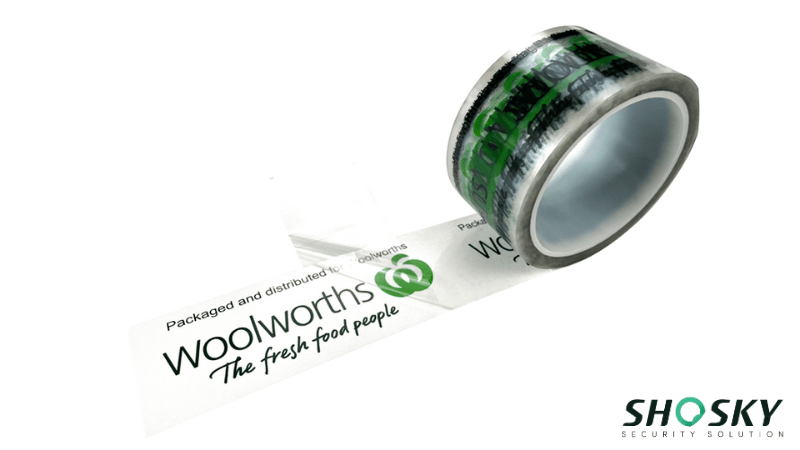When research from the Ellen MacArthur Foundation revealed that by 2050, there could be more plastic than fish in the ocean by weight, companies started taking a serious look at their packaging choices. Since then, tamper-evident packaging has taken steps toward cleaner, more responsible designs.
Bioplastics, recycled content, and compostable films are replacing harmful plastics in security seals, tapes, and containers. In this article, we will explore how sustainable tamper-evident packaging is evolving, what materials and technologies are driving it, and how companies can align security with sustainability.
Understanding Tamper-Evident Packaging and Its Importance
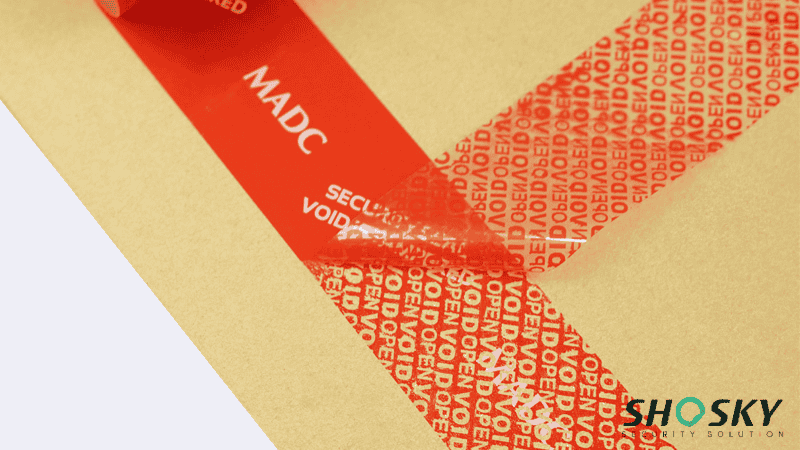
Tamper-evident packaging is designed to show clear signs if a product has been opened or interfered with. These indicators include seals that can’t be replaced, shrink bands that break on opening, and labels that reveal a hidden message when peeled.
While tamper-evident packaging is used across many sectors, the pharmaceutical industry leads, making up around 32% of global demand. This need grew after the 1982 Tylenol incident, which triggered major safety reforms.
Today, it’s not just medicines—ready-to-eat food, drinks, cosmetics, electronics, and even e-commerce rely on tamper-evident features to protect products during shipping and in-store display.
There’s also a strong link between tamper-proof packaging and brand trust. Visible packaging security increased customer confidence by 64% and willingness to pay more by 27%. For companies, it reduces returns, builds consumer loyalty, and helps protect against counterfeits and lawsuits. In short, it plays a critical role in product safety and brand reputation.
What Makes Tamper-Evident Packaging Sustainable?
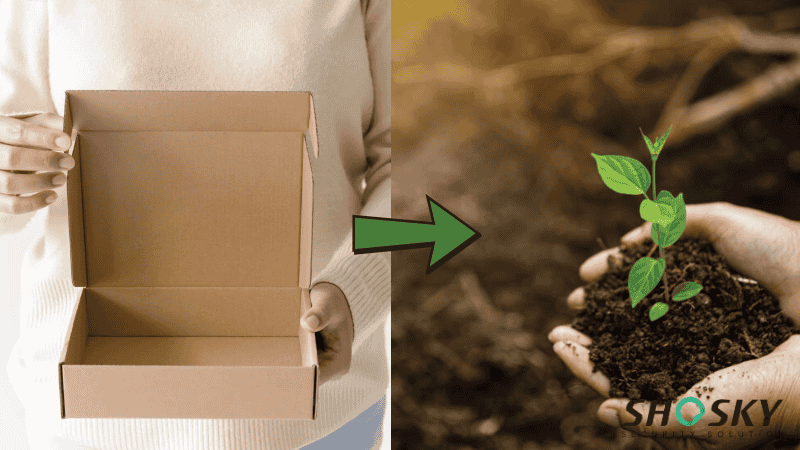
Sustainable tamper-evident packaging combines product protection with eco-friendly practices. In this packaging, traditional plastic and multi-layered packaging are replaced with bio-based options like biodegradable, recyclable, and compostable packaging materials. Using sustainable materials can help keep 2.7 million tons of packaging waste out of landfills every year.
- Biodegradable materials break down naturally over time, minimizing long-term accumulation in landfills.
- Recyclable materials can be processed and reused, conserving resources and reducing the need for virgin material production.
- Compostable materials decompose under specific composting conditions, turning into nutrient-rich soil.
Switching to sustainable tamper-evident solutions cuts greenhouse gas emissions as well. A study found that plant-based tamper-proof packaging emits 37–42% less CO₂ across its lifecycle compared to conventional plastic. With 73% of consumers willing to adjust their buying habits to help the planet, using sustainable tamper-evident packaging is no longer just an option—it’s a brand necessity.
6 Types of Eco-Friendly Tamper-Evident Packaging Materials
1. Biodegradable Seals
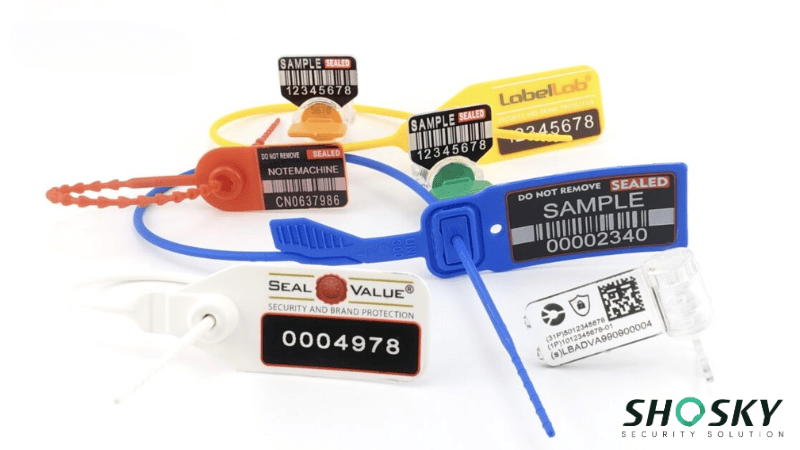
Biodegradable security seals are made from plant and paper-based materials that break down naturally over time, reducing waste and environmental impact. These materials are non-toxic, and they break down in industrial composting facilities.
The process usually takes 90 to 180 days. They show clear signs of tampering when broken, and the damage is irreversible once compromised. Here is more information about different types of biodegradable seals:
- Plant-Based Polymers: Derived from renewable resources like corn, sugarcane, or cellulose, these polymers decompose after use. They offer reliable tamper-evident features and are becoming popular in food, beverage, and pharmaceutical packaging. These materials break down into organic compounds, leaving little to no residue in landfills.
- Paper-Based Seals: Sustainable paper seals are fully compostable, providing an eco-friendly alternative to plastic packaging. These seals are coated with specialized adhesives or tamper-evident inks that react when the package is tampered with. Paper-based seals break down in composting systems, minimizing environmental impact.
Examples: Biodegradable shrink wraps, Plant-based tamper-evident bands, and Compostable paper seals.
2. Recyclable Tamper-Evident Materials

Recyclable tamper-evident materials are a sustainable choice that helps reduce waste by enabling the packaging to be processed and reused. By using recycled materials, these solutions contribute to a circular economy and minimize the need for virgin plastic or paper.
Ideal for industries concerned with sustainability, they ensure that the product’s security is maintained while allowing for responsible disposal and recycling. Here is more information about different types of recyclable tamper-evident materials:
- Recycled Plastics: Post-consumer recycled plastic (PCR) is used in tamper-evident seals to replace virgin plastic. The use of PCR can reduce the need for new plastic production, which helps decrease carbon emissions. Recycled plastics are often processed into shrink wraps or tamper-evident bands, making them a sustainable choice for brands looking to reduce their environmental impact.
- Recycled Paperboard and Cardboard: Recycled paperboard and cardboard are suitable for tamper-evident packaging in cartons, bags, or seals. These materials also offer a reliable, eco-friendly solution for protecting products while ensuring that the packaging can be recycled after use. Available in different sizes and shapes, they offer versatility in packaging designs.
Examples: Recycled PET tamper-evident bands, Tamper-evident cartons made from recycled board, and Recyclable fiber-based seals.
3. Water-Soluble Tamper-Evident Solutions
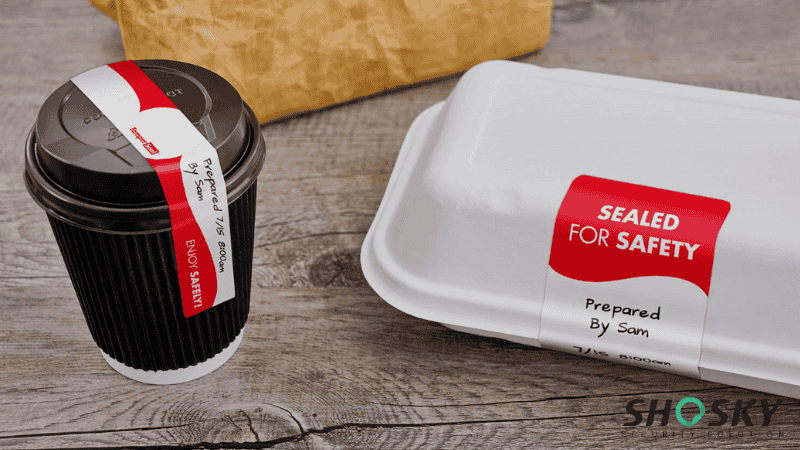
Water-soluble tamper-evident solutions dissolve completely in water, leaving no harmful residues behind. These innovative materials are ideal for industries like food and beverage packaging, where disposal and environmental concerns are top priorities.
They offer peace of mind by ensuring that no waste accumulates in landfills and that this smart packaging is fully biodegradable under the right conditions. Here is more information about different types of water-soluble tamper-evident solutions:
- Water-Soluble Adhesives: These adhesives are designed to dissolve when exposed to water, offering a completely eco-friendly solution. They are used in tamper-evident security seals that disappear upon tampering or exposure to water. They ensure added security while being compatible with sustainable packaging ideas.
- Water-Soluble Films: Similar to water-soluble adhesives, these films dissolve upon exposure to water, leaving no residue or waste. They offer a unique form of tamper-evident protection by ensuring that the packaging material is gone once the product is accessed.
Examples: Water-soluble adhesive labels, Tamper-evident films that dissolve in water, and Wash-away security seals.
4. Sustainable Plastic Alternatives
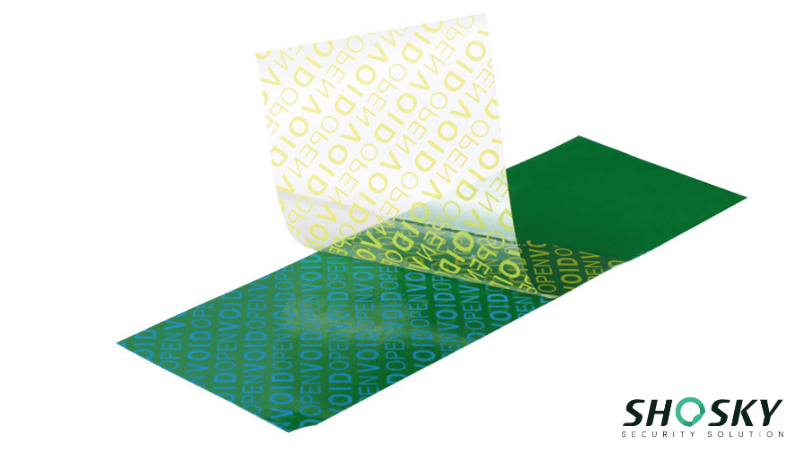
Sustainable plastic alternatives derived from renewable feedstocks provide eco-friendly alternatives to petroleum-based tamper-evident materials, with distinct formulations for different security applications.
These alternatives provide the same tamper-evident features that help ensure product safety during transport and storage. Here is more information about different types of sustainable plastic alternatives:
- Bioplastics: Made from plant-based materials like corn starch or sugarcane, bioplastics are biodegradable and provide tamper-resistant security without relying on petroleum-based plastics. These materials are suitable for various applications in the packaging industry, from tamper-evident containers to product seals.
- PLA (Polylactic Acid): PLA is also a biodegradable plastic made from plant starch or sugarcane and is ideal for tamper-evident packaging. PLA offers the same level of durability and security as conventional plastics, but it breaks down into compostable elements, making it an eco-friendly choice.
Examples: PLA tamper-evident seals, Bioplastic security labels, and Compostable bio-based shrink films.
5. Eco-Friendly Shrink Films and Seals

Compostable shrink films provide secure tamper-evident packaging for bottles, jars, and other containers while offering end-of-life biodegradability. They are an excellent alternative to traditional plastic shrink wraps.
They offer the same visual indication of tampering – tearing or stretching upon opening – but with a lower environmental impact. Here is more information about different types of eco-friendly shrink films and seals:
- Compostable Shrink Films: Made from renewable resources like plant starch or cellulose, these shrink films shrink around products to create a secure packaging solution. These compostable films ensure that products stay protected while being suitable for a range of industries concerned with sustainability.
- Sustainable Adhesive Films: These films use eco-friendly, water-based adhesives instead of harmful chemicals or solvents. They are compatible with eco-conscious packaging solutions and provide security for products in transit, ensuring both product protection and environmental responsibility.
Examples: Cellulose-based compostable shrink wrap, Recycled polyethylene shrink films, and Water-based adhesive tamper-evident labels.
6. Tamper-Evident Paper Products
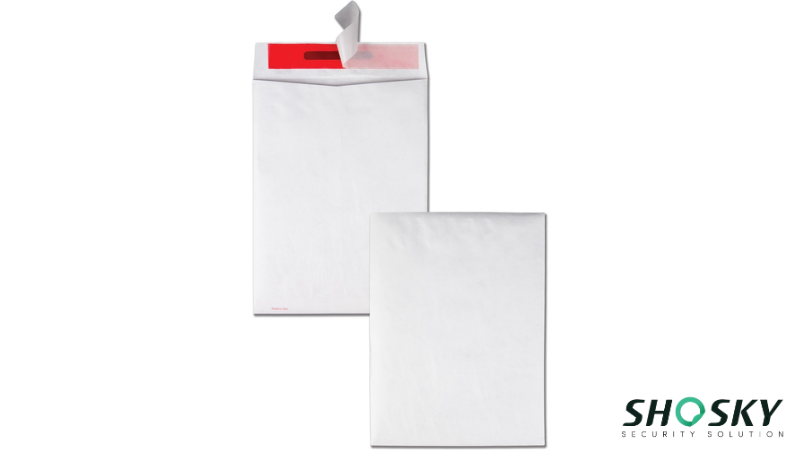
Security paper with built-in tamper-evident features represents one of the most versatile sustainable packaging solutions. They offer secure packaging solutions for smaller items, such as documents, retail goods, or pharmaceuticals.
These products are made from recycled or sustainably sourced paper, making them fully recyclable and eco-friendly. Here is more information about these tamper-evidence options:
- Tamper-Evident Paper Bags and Envelopes: These tamper-evident bags and envelopes are designed to secure items while offering a fully recyclable solution. Made from kraft paper or recycled paper, they feature tamper-evident properties like tear strips, adhesives, or tamper-evident ink and are suitable for retail and industrial applications.
- Security Paper: Security paper with tamper-evident features, such as specialized ink or adhesives, ensures that packaging remains intact during transit. The paper is designed to be fully recyclable and offers an eco-friendly solution for secure mailing and retail applications. This paper can be used in various forms, from bags to envelopes, to offer flexibility and versatility for different industries.
Examples: Tamper-evident kraft paper bags with security seals, Recyclable paper envelopes with tear strips, and Security paper labels with tamper-reactive ink.
Eco-Friendly Alternatives to Traditional Tamper-Evident Solutions
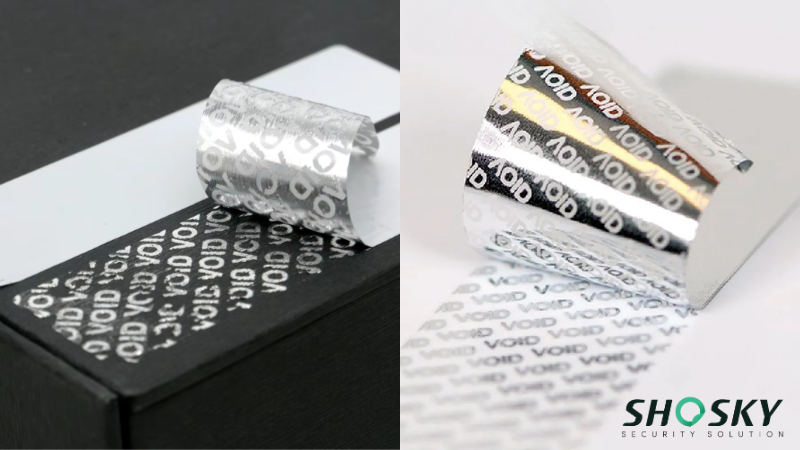
Many industries still rely on traditional plastic-based tamper-evident seals. These materials are durable and effective, but they contribute to long-term environmental harm and waste buildup. As concerns over plastic pollution grow, businesses are exploring eco-friendly tamper-evident packaging that offers both protection and sustainability.
| Feature | Traditional Tamper-Evident Solutions | Eco-Friendly Alternatives |
|---|---|---|
| Material Composition | Petroleum-based plastics (e.g. PVC, PET) | Plant-based polymers, paper, recycled materials |
| Environmental Impact | Non-biodegradable, high landfill load | Compostable, recyclable, reduced waste output |
| Tamper Evidence | Visible breakage or distortion | Same clear signs—can include ink or adhesive reaction |
| Disposal Requirements | Often requires special handling | Compatible with composting or regular recycling |
| Application Areas | Pharma, food, electronics | Pharma, food, retail, documents (broader use) |
| Shapes and Sizes | Limited, standardized | Available in different sizes and shapes |
| Price Consideration | Generally lower initial price | Price varies, but long-term savings in green credentials |
| Consumer Perception | Seen as outdated by eco-conscious buyers | Adds peace of mind and modern appeal |
Switching to environment-friendly seals doesn’t mean giving up security. Biodegradable and sustainable packaging materials can offer the same level of tamper resistance while reducing environmental harm. Businesses that adopt these solutions send a clear message—they care about product safety and the planet.
How to Implement Sustainable Tamper-Evident Packaging in Your Business
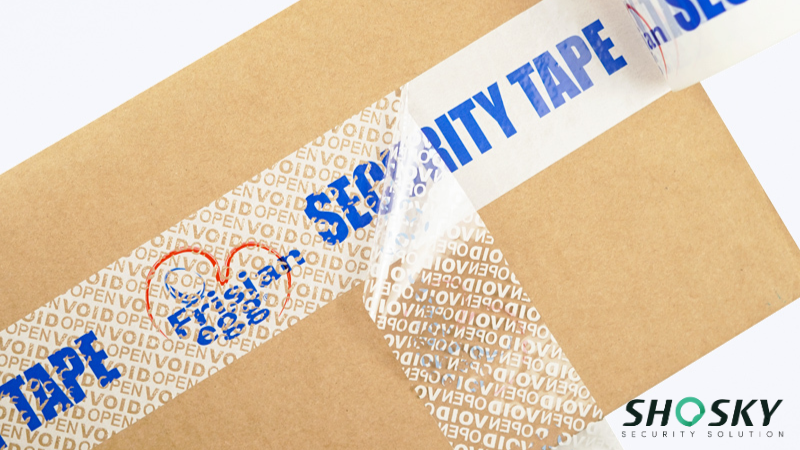
Implementing sustainable tamper-evident packaging starts with choosing the right materials for your product. Consider your product’s form, weight, and storage needs, like freezing or long-term shelf life. For example, food packaging requires seals and security tapes that maintain freshness and product integrity. Look for options that come in different sizes and shapes to ensure proper fit and convenience.
Next, contact a reliable supplier who offers biodegradable, recyclable, or compostable materials. Ask for certifications and samples so you can discover which tamper-evident options match your needs. Building long-term partnerships can help you stay updated on eco-friendly packaging trends and reduce lead times. A good supplier will also help you grab the most cost-effective and sustainable solutions.
Before launching, test the materials for durability and tamper resistance. Simulate real-life transit and storage conditions to ensure the seal holds up during shipping, handling, or freezing. Lastly, integrate your sustainable choices into your brand message. Share your packaging story with customers—it builds trust and aligns with values that modern consumers care about.
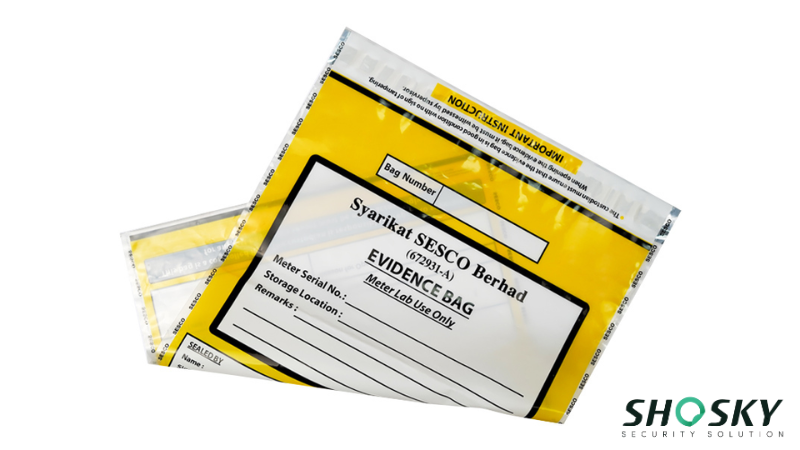
FAQs
Are sustainable tamper-evident seals as secure as traditional ones?
Yes, sustainable tamper-evident seals are designed to provide the same level of security as traditional ones.
How can businesses reduce the cost of eco-friendly packaging?
Businesses can reduce costs by sourcing materials in bulk or opting for simplified designs.
Can I recycle tamper-evident packaging materials?
Many tamper-evident packaging materials are recyclable, but it depends on the type. Always check local recycling guidelines to ensure proper disposal.
Conclusion
Switching to sustainable tamper-evident packaging is more than a packaging change—it’s a chance to lead with integrity and care. With options suitable for different sizes, shapes, and transit needs, eco-friendly materials are versatile and practical. Start with one product line, test it, and scale from there. Small changes today can lead to big results for your brand—and the world around us.
Upgrade with Shosky Security’s Sustainable Tamper-Evident Packaging
Go green without compromising on protection. Shosky Security offers reliable, eco-smart seals and packaging solutions. Reach out now to find the right fit for your business.
